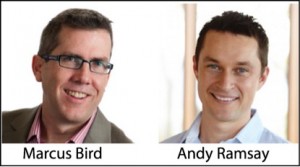The Wellness Journey
Marcus Bird, MEI, DIP, HSC, KIN
Andy Ramsay, BHSc, ACUP
In the 30 years that Andy and I have been practicing our craft, one thing has been highlighted to us: you have to create a journey for clients to follow. When we started showing other practitioners how we built a successful practice, we were surprised at how many practitioners did not outline this for their clients and patients. So many practitioners did not understand the importance of providing a sequence, a series of steps, if you will, for clients to follow to take them from what we call Pain Island (suffering) to Pleasure Island (wellness).
An Age of Impatience
I think we all understand that clients present to us at a time of need, a time of pain, be it physical or emotional. They are initially looking for relief from this pain in the fastest way possible. The western medical model fulfills this role perfectly by providing for a “quick fix” to relieve the pain that the patient is suffering. The unfortunate problem with this is that it is not self-empowering and it leads the patient to hand over control of his or her health to the doctor. It has led to an environment of reliance on the doctor-patient relationship and, in turn, a form of disempowerment.
The new healthcare environment is demanding a new and more informative relationship – one that is self-empowering and ultimately leads to the removal of pain. With the advent of the internet, patients are more self-informed than ever. They are now actively searching online for solutions to alleviate their pain by self-diagnosing and self-medicating. We know this is problematic at best, and dangerous at worst, yet it is more and more prevalent. There is even a name for this phenomenon – cyberchondria. In June 2014, internetworldstats.com reported there were over 3 billion internet users worldwide1 and that of these, 60% actively searched for health information. That’s a total of 1.8 billion people searching for health-related solutions in 2014 alone.
When we couple this with the hyper-connected, rapid speed of our smart-phone enabled, technological lives, we get the compounding effect of impatience. In a Boston Globe article entitled “Instant gratification is making us perpetually impatient,”2 researcher Ramesh Sitaraman, a computer science professor at UMass Amherst, stated, “We’ve come to expect things so quickly that we found people can’t wait more than a few seconds for a video to load.” He examined the viewing habits of 6.7 million internet users in a study released last fall. “How long were subjects willing to be patient? Two seconds. After that they started abandoning,” Sitaraman said. “After five seconds, the abandonment rate is 25%. When you get to 10 seconds, half are gone.”
Shifting Patients Toward Self-Empowerment
All this activity and impatience creates an amazing opportunity for us as healthcare professionals to provide a solution that is sequenced and specific to the pain that our clients are suffering. We have to create something that Google and Wikipedia cannot – a specific journey for our clients to follow. Here we create a journey for our clients from Pain Island to Pleasure Island. Imagine that our new client – let’s call her Jane – is standing on an island. It’s an island of pain and suffering, all alone in the world. Here she stands, looking for alleviation from her suffering. In most cases, a practitioner will come along and remove Jane’s suffering by providing a quick one-off solution, or maybe a series of sessions lacking obvious direction. Practitioners arrive in their boats of solutions, provide the fix, and then leave in their boats. In this one-off session, the client gains quick, often short-term relief, but is not empowered to move toward long-term wellness.
If, on the other hand, we as practitioners can connect with Jane on her island of pain, providing a journey of wellness through a specific sequence of steps that move her from Pain Island to Pleasure Island, it will lead to long-term, empowered wellness. In essence, we are saying: “Here, Jane, I have a boat that can take you to Pleasure Island and long-term wellness – hop on board. Now, I am not going to steer the boat, but rather, guide you through the channels and the ports we’ll need to stop at along the journey to wellness.” Jane is now empowered to steer her own ship with the guidance of an expert, a little like how a sea pilot guides a ship into port. In this paradigm, we provide a series of sequenced sessions designed to empower Jane to wellness. Our sequenced solution also avoids the sticker shock of individual appointments that we need to make after each visit. Jane is empowered to drive her own boat, she has an understanding of what she needs to do, and she has a clear road map to follow.
What This Requires of Us
When we embrace this model of wellness, a number of interesting things happen. The first is that we help our clients to feel safe in knowing that there is a step-by-step journey that they are taking, and they can see it in 3 stages of our work: the beginning, the middle, and, most importantly, the end. The second is that this leads our clients to feel safe about the cost, safe about the result, and safe about engaging us as their health provider. However, for this model to be embraced, we have to be clear and confident about our ability to first understand where Jane is and what she is experiencing, and secondly, to know the solution for her pain. We need to accomplish this in a different way from the standard model of health.
Firstly, we have to understand the patient’s pain through personal experience, clinical experience, or formal training. We then have to outline the journey and the steps that a person like Jane, suffering from this problem, would generally need to take to become empowered and eventually arrive at Pleasure Island. Secondly, we need to deliver this solution to our potential clients in a way that does not guarantee results, but rather offers a guided journey to wellness, naturally with adjustments and changes to suit each individual person.
So, to embrace this new paradigm, meet the demand of a searching audience, and work within the environment of an impatient generation we must…
- Deeply understand the issue or pain our client is suffering from
- Create the sequenced step-by-step road map that will take a client from Pain Island to Pleasure Island
- Share this solution in a way that provides confidence and sureness that this solution will be the one that empowers the client to long-term wellness
Within this model, we move away from the alleviation of suffering and into the self-empowerment of wellness. Our potential clients are already looking for this self-empowered solution; they are already searching the internet, trying to find answers. Maybe it is time that we help them with these answers in a deeper and more complete way – meeting their desire for self-empowerment, rather than just providing a quick fix to their suffering.
 Andy Ramsay, BHSc Acup, and Marcus Bird, MEI, Dip HSc Kin, both had successful careers as practitioners – Andy as a Traditional Chinese Medicine doctor, and Marcus as a kinesiologist and counselor/coach. Both were clinic owners and in private practice. Andy and Marcus both experienced the struggle that most practitioners go through, which leads to low pay, overwork, and deep frustration. Having taught themselves a system to overcome this all-too-common situation, Andy and Marcus started the Wellness Leadership Academy and now teach other practitioners how to beat the statistics and attract more clients, make more money, and have more time to deliver their true message on the planet. They can be reached at [email protected]; and [email protected].
Andy Ramsay, BHSc Acup, and Marcus Bird, MEI, Dip HSc Kin, both had successful careers as practitioners – Andy as a Traditional Chinese Medicine doctor, and Marcus as a kinesiologist and counselor/coach. Both were clinic owners and in private practice. Andy and Marcus both experienced the struggle that most practitioners go through, which leads to low pay, overwork, and deep frustration. Having taught themselves a system to overcome this all-too-common situation, Andy and Marcus started the Wellness Leadership Academy and now teach other practitioners how to beat the statistics and attract more clients, make more money, and have more time to deliver their true message on the planet. They can be reached at [email protected]; and [email protected].
References:
- Internet Users in the World: Distribution by World Regions – 2014 Q2. June 30, 2014. Internet World Stats Web site. http://www.internetworldstats.com/stats.htm. Accessed April 14, 2015.
- Muther C. Instant gratification is making us perpetually impatient. February 2, 2013. The Boston Globe Web site. http://tinyurl.com/avusz2k. Accessed April 14, 2014.









